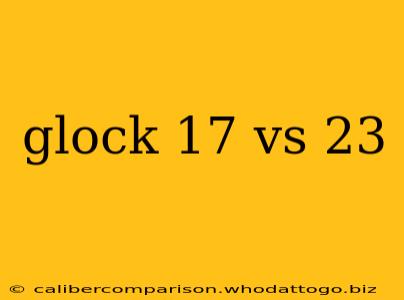Choosing between the Glock 17 and Glock 23 often comes down to personal preference and intended use. Both are incredibly popular handguns, but their differences in size, caliber, and capacity make them better suited for different situations. This in-depth comparison will help you determine which Glock is right for you.
Caliber: The Core Difference
The most significant difference lies in their caliber: the Glock 17 is chambered in 9x19mm Parabellum (9mm), while the Glock 23 is chambered in .40 S&W. This impacts several key aspects:
Recoil and Shootability:
- 9mm (Glock 17): Generally considered to have less recoil, making it easier to control, especially for new shooters or those with smaller hands. This translates to faster follow-up shots and improved accuracy.
- .40 S&W (Glock 23): Packs a more substantial punch, leading to more noticeable recoil. While experienced shooters can manage this, it can be challenging for beginners. The increased recoil can also impact accuracy, particularly in rapid fire.
Stopping Power:
- .40 S&W (Glock 23): Offers greater stopping power due to its larger caliber and heavier projectile. This is a crucial consideration for self-defense scenarios.
- 9mm (Glock 17): While offering less stopping power than .40 S&W, modern 9mm ammunition has significantly improved in this area, with many high-performance rounds delivering comparable stopping power to older .40 S&W rounds. Furthermore, the increased capacity of the 9mm Glock 17 can offset the perceived difference in stopping power.
Size and Concealed Carry:
- Glock 17: Larger and heavier, making it less ideal for concealed carry, especially for individuals with smaller builds. It's better suited for range use, home defense, or open carry situations.
- Glock 23: More compact and lighter than the Glock 17, making it a popular choice for concealed carry. Its smaller size allows for easier concealment under clothing.
Magazine Capacity:
- Glock 17: Generally holds a higher capacity than the Glock 23. Standard magazines typically hold 17 rounds, with extended magazines available offering even greater capacity.
- Glock 23: Standard magazines typically hold 13 rounds, though extended magazines are also available.
Ergonomics and Handling:
Both pistols share Glock's renowned ergonomic design, featuring a consistent grip angle and a smooth trigger pull (once broken in). However, the size difference significantly impacts how they feel in the hand. The smaller Glock 23 might be more comfortable for shooters with smaller hands, while the Glock 17 might be preferred by those with larger hands.
Cost and Availability:
Pricing and availability typically vary depending on location and retailer, but both models are widely available and generally fall within a similar price range.
Conclusion: Which Glock Should You Choose?
The "better" Glock depends entirely on your needs and priorities.
-
Choose the Glock 17 if: You prioritize shootability, higher capacity, and lower recoil. You're primarily using the firearm for range practice, home defense, or open carry.
-
Choose the Glock 23 if: You prioritize concealed carry, a more compact size, and greater stopping power (though modern 9mm rounds are rapidly closing that gap). You're willing to accept higher recoil in exchange for easier concealment.
Ultimately, the best way to decide is to handle both pistols, if possible, and see which one feels more comfortable and natural in your hand. Consider your individual needs, experience level, and intended use to make an informed decision.

